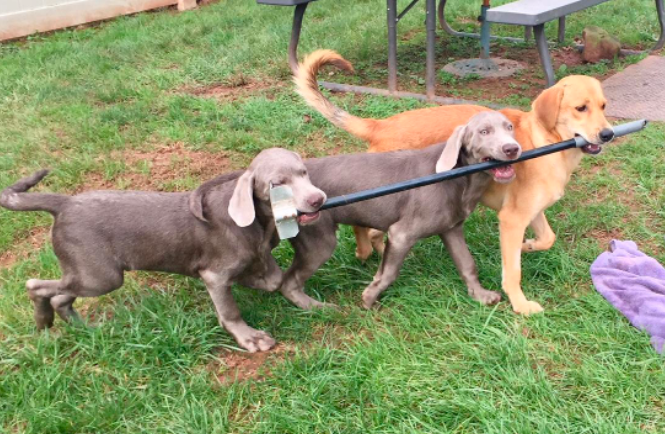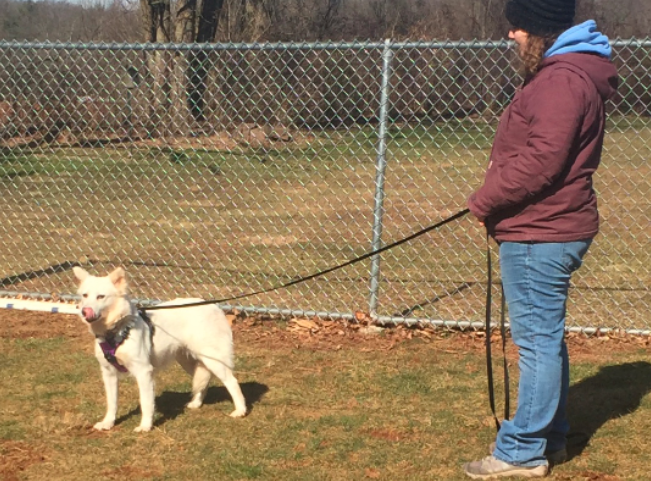
Using Stairs
Start by sitting on the bottom step (yet leaving a gap, so there is a pathway to the top) and have some tasty treats. Call the dog to you and reward with a treat. Back yourself up one step, call the dog to you and see if they will put a paw on the first step. Reward with a treat anytime they touch the step with their paw.
Continue to back yourself up (or down), step-by-step, and repeat the process.
If sitting on the steps does not work, try turning your whole body around and walking up or down step-by-step while rewarding with treats.
Sometimes, dogs will be more likely to follow a person when the dog is attached to a leash. Try leash walking the dog up and down the stairs.
Also, other dogs are great teachers, so if you have another dog that will run up and down the stairs, use that dog to teach your shy dog. Once your dog learns to maneuver the stairs, they will act like they’ve been doing it all their life!
Tips for Housetraining
Puppy mill survivors can sometimes be a challenge to housebreak. Understandably, they are confused about where to “go.” They have been forced to defecate in their living areas and have had no other choice. Now, there is a choice where to go potty – but we must patiently teach them where that is. Unfortunately, there is no magic cure. However, by maintaining a routine and sticking to it, you should get results. Keep in mind that some dogs take longer to learn than others.
1. . Feeding your dog at the same time every day will help create a regular “potty” schedule.
2. Keep your dog on a scheduled potty routine consistently at the same time every day as much as possible. Your dog will then know when they can expect to go outside and do their business. Another part of the routine should be going out the same door and taking them to the same area each time, so the dog learns where to go when they need to go out.
3. Take your dog out often, even if it means 2:00 a.m. potty breaks for a week. Take your dog out immediately after they’ve eaten and every two to three hours after that for the rest of the day. Take them out after periods of indoor play as well, just as you would a puppy. If you are not home all day, do this as often as possible.
4. If you have other dogs, they can help! If the shy dog sees them going potty outside, they are likely to imitate them. It also helps if they can smell where they have pottied.
 5. If you have a fenced yard, allow your dog to roam freely to do their business instead of on a leash. Even though you want them to have space and privacy to go, it is important that you go outside in the yard with them instead of letting them out and closing the door. Being outside with your dog is important for a few reasons. First, you can direct them to the smelly pee area and instruct them nicely to “Go potty!” and pointing in that general direction. If you are inside, they will likely sit at the door whining or scratching until you let them back in. If you are outside, you can confirm that they pottied. You may need to wait them out until they go; be patient! If you do not have a fenced yard, try using a long leash (over 10 feet) to give your dog some space and privacy. You may need to pretend you are ignoring them and not watch what they are doing because some dogs do not like to be watched while they potty.
5. If you have a fenced yard, allow your dog to roam freely to do their business instead of on a leash. Even though you want them to have space and privacy to go, it is important that you go outside in the yard with them instead of letting them out and closing the door. Being outside with your dog is important for a few reasons. First, you can direct them to the smelly pee area and instruct them nicely to “Go potty!” and pointing in that general direction. If you are inside, they will likely sit at the door whining or scratching until you let them back in. If you are outside, you can confirm that they pottied. You may need to wait them out until they go; be patient! If you do not have a fenced yard, try using a long leash (over 10 feet) to give your dog some space and privacy. You may need to pretend you are ignoring them and not watch what they are doing because some dogs do not like to be watched while they potty.
6. When your dog does finally potty outside, reward them immediately! This means taking high-value treats outside with you and rewarding as soon as they’ve gone. If you wait to reward until you go back in the house, they may be confused thinking they are rewarded for returning to the house.
7. Clean up any indoor accidents with an enzymatic cleaner. Take note that dogs may be more likely to have accidents on soft flooring such as carpets or rugs. Babygating them in non-carpeted areas or away from carpeted rooms will help make clean up easier!
8. Crate training is also an option, but first you will have to teach your dog to become comfortable with the crate.
![]()
 Crate Training
Crate Training
Some dogs are fearful of crates, but there are also many that prefer the smaller space of a crate. Make the crate a cozy place to live by putting a blanket and some toys inside. You may even choose to put a blanket over the top of the crate to create a private den if your dog prefers that. Make sure the size of the crate is appropriate for your dog. You do not want it so small that the dog is cramped. You also do not want it too large that they have room to potty and lie away from it. There are many ways to acclimate your dog to a crate, especially if they are food motivated. Feeding meals in the crate or giving them a peanut butter-filled Kong are good starters. You may have to start by feeding the meal right outside of the crate and then move it inside the crate for the next feeding. Gradually with each feeding (or when your dog is ready), move the bowl farther and farther into the crate until your dog is going into the crate. Leave the crate door open for a few more feedings and then eventually you can close the door.
If your dog is not fond of the crate, but you want to prevent potty accidents on your living room carpet, try to baby gate in a smaller room or area with no rugs. This way you can keep your dog in a designated area and still give them the space they need.
![]()
Final Thoughts
We strive to help each dog based on their individual learning level. Just like humans, each dog is different and some respond more quickly than others to these training techniques. We have dogs that took several months or even over a year to accomplish a task that may take another dog only a few days to learn. You may need to be creative to come up with safe management ideas of your own that work for your dog. They may also respond differently to one person in your household than another, particularly men vs. women. In some cases, you may need to realize some of these very fearful dogs do best at home and will never do well playing at a dog park or socializing with groups of people at the local parade or town events. Sometimes, the best thing for them is the safety of their home with their family.
For all dogs, be patient and do not overwhelm them with too many experiences at one time. This is called “trigger stacking.” Trigger stacking is defined as “Stress accumulation due to exposure of multiple triggers, either simultaneously or close enough in time that the dog’s reactivity has not returned to normal.”
With love and patience, your dog will continue to grow at their own pace. Many adopters of shy, fearful, and puppy mill dogs will tell you that the bond you develop will be one of the strongest unions you will experience. Helping them to progress from a scared creature to a happy dog is what rescue is all about. Thank you for taking the journey with them.
![]()
Recommended Reading & Resources
Positive Training:
The Power of Positive Dog Training Pat Miller
Bringing Light to Shadow
Pam Dennison
Bones Would Rain from the Sky Suzanne Clothier
Train Your Dog Positively
Victoria Stilwell
The Secret Language of Dogs Victoria Stilwell
Shy & Fearful Dogs:
A Guide to Living With & Training a Fearful Dog – Debbie Jacobs
Rescue Your Dog from Fear
Peggy O. Swager
The Cautious Canine
Patricia McConnell
Help for Your Fearful Dog
Nicole Wilde
Puppy Mill Dogs, SPEAK!
Chris Shaughness & Chris Slawecki
Reactive Dogs:
Scaredy Dog
Ali Brown
Click to Calm
Emma Parsons
Resource Guarding:
Mine!
Jean Donaldson
Separation Anxiety:
Treating Separation Anxiety in Dogs
Malena DeMartini-Price
House Training:
Way to Go!
Patricia McConnell
Hard to Housetrain
Peggy O. Swager
Here is a list of internationally recognized positive dog trainers that are great resources:
Debbie Jacobs
Sophia Yin/ Cattledog Publishing
Pat Miller
Rise Van Fleet
Ali Brown
Nicole Wilde
Patricia McConnell
Ian Dunbar
Chirag Patel
Jean Donaldson
Victoria Stilwell
Peggy O. Swager
Zak George
Nicole Skeehan
Other Helpful Sites
Kyra Sundance:
www.domorewithyourdog.com
Humane Society of the United States
ASPCA

